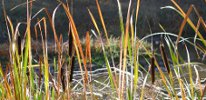
Archived Workshops/References
Santa Cruz Long-Toed Salamander
Description
The Santa Cruz long-toed salamander (Ambystoma macrodactylum croceum) is listed by the federal government as endangered. It is found in a very narrow geographic range, from Aptos to Moss Landing, California. It breeds in mostly ephemeral ponds and adults then migrate upslope into mostly scrublands and woodlands.
The Elkhorn Slough Coastal Training Program will add more content here as we, ourselves learn more. Our work entails sharing the best, most up to date scientific information with the variety of audiences working to protect, manage, and recover the species.
Our goal is to assist through education, networking, and group process assistance, professionals in creating a speedy and effective recovery of this species. We envision that this will first entail basic education about the ecology and conservation issues for the species. We will then tier up to detailed management information, and onto the best science to inform recovery of each population, and then the species as a whole.
Please stay in touch and, if you can, assist us as you can with our goals.
Training Programs
Documents and Publications
| TITLE DATE ADDED |
AUTHOR SOURCE |
DESCRIPTION |
|---|---|---|
| WORKSHOP MATERIALS | ||
| SCLTS Workshop Presentation PDF, 17.4MB Jun 16 14 |
Wesley Savage Elkhorn Slough Coastal Training Program 2014 |
Workshop presentation |
| PEER-REVIEWED PUBLICATIONS | ||
| A Comparison of the Life Histories of Coastal and Montane Populations of Ambystoma macrodacytlon in California PDF, 3.1MB Apr 23 09 |
James D. Anderson The American Midland Naturalist 77(2):323-355 1967 |
Much of this document is out-of-date, but pay especial attention to the description of the habitat of Santa Cruz long-toed salamander in this historic literature. |
| Recovery Plan (Draft): Santa Cruz long-toed salamander PDF, 23.6MB Apr 23 09 |
US Fish and Wildlife Service USFWS 2004 |
This is the latest draft recovery plan for the Santa Cruz long-toed salamander. |
| Species account: Santa Cruz long-toed salamander DOC, 9MB Apr 23 09 |
American Society of Ichthyology and Herpetology 1963 |
This is a historical document describing the range and relationship of the Santa Cruz long-toed salamander. It is not up to date, but is an interesting piece of history. |
| Using Cameras to Monitor Tunnel Use by Long-toed Salamanders: An informative cost-efficient technique PDF, 2.3MB May 23 14 |
Katie S. Pagnucco, Cynthia A. Paszkowski, and Garry J. Scrimgeour Herpetological Conservation and Biology 6(2):277-286 MAy 2011 |
Study of wild life crossing and corridor use by amphibians. |
| OTHER INFORMATION | ||
| Amphibian Mortality on Roads: A case study in Santa Cruz Long-toed salamander habitat PDF, 4.7MB May 23 14 |
Michael Hobbs San Jose State University 2013 |
Master Thesis |
| California Wildlife Habitat Relationships System: long-toed salamander species account PDF, 24KB Apr 23 09 |
California Department of Fish and Game California Interagency Wildlife Task Group 2007 |
This is some more or less up to date information on the long toed salamander species in California. |
| Sampling Procedures for Determining Presence or Absence of the Santa Cruz Long-toed Salamander (Ambystoma macrodactylum croceum) PDF, 70KB Apr 23 09 |
John M. Brode US Fish and Wildlife and California Department of Fish and Game May 1993 |
If suitable Santa Cruz Long-toed Salamander (SCLTS) breeding habitat occurs on the project site, the sampling procedures included here shall be followed. Suitable SCLTS breeding habitats are ponds that hold water in "normal" rainfall years at least through the end of May. SCLTS usually migrate and breed during the winter rains, typically January through February, depending upon rainfall patterns. |
| Santa Cruz County Planning Department Policy: Site Disturbance and Impervious Surface in the Salamander Protection Zone PDF, 57KB Apr 22 09 |
Santa Cruz County Planning Department County of Santa Cruz 1/1/03 |
This policy outlines government policy for disturbance by development in areas where the Santa Cruz long toed salamander is found. |
| Tissue Collection Protocol for Genetic Research PDF, 270KB Apr 21 09 |
K.E. Leyse, A.J. Lind, W.K. Savage, H.B. Shaffer, and M.R. Stephens Elkhorn Slough Coastal Training Program April 2009 |
This is a white paper describing techniques and skills for collecting tissue from amphibians in genetic research projects. For more information, correspond with: Amy Lind Section of Evolution and Ecology - Storer Hall One Shields Avenue University of California, Davis 95616 ajlind@ucdavis.edu (530)-752-1112, (530)-759-1702 |
Links
| TITLE | DATE ADDED |
|---|---|
| Federal Register: HCP for Santa Cruz long-toed salamander http://www.klamathbasincrisis.org/esa/permit/salamander010907.htm |
Mar 06 09 |
